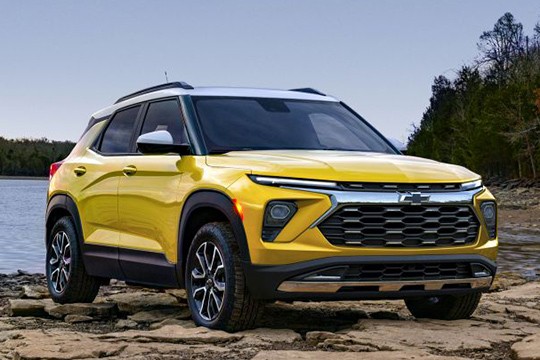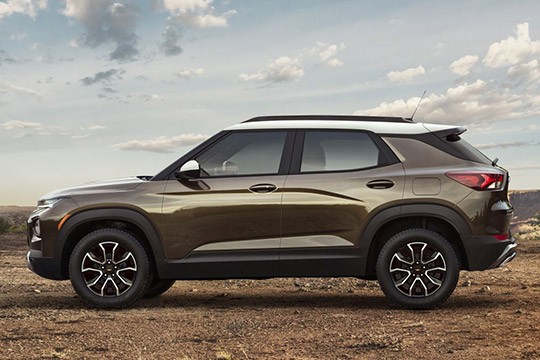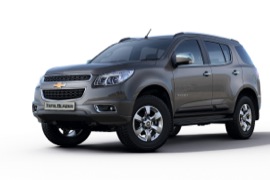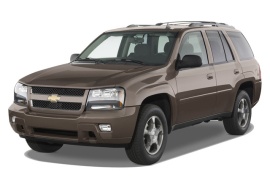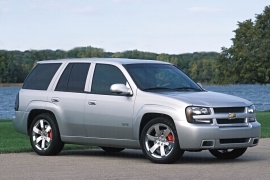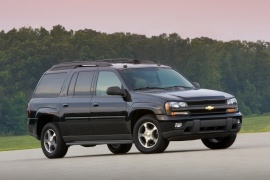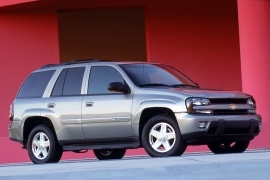CHEVROLET TrailBlazer Models/Series Timeline, Specifications & Photos
First production year: 2000
Engines: Gasoline, Diesel
Body style: SUV (Sports Utility Vehicle)
While in the U.S., the TrailBlazer was no longer offered, in other countries, that vehicle was still sold, although as a crossover and with a slightly different spelling as the Trailblazer.
In 2012, Chevrolet introduced the Trailblazer for various countries based on the same chassis as the Colorado pickup. Almost eight years later, the bow-tie brand shrunk the vehicle again and used the Buick Encore's platform to produce it. But, in 2023, the crossover got a facelift that kept it fresh on the market and with updated technologies inside.
The 2024 model-year kept the same idea of headlights mounted lower in the bumper and with its DRLs placed above them at the hood's edge. But, unlike its predecessor, it featured a different grille with a honeycomb mesh, and the badge was placed on the chromed horizontal slat, not above it as on the 2020 version. Still, Trailblazer's profile kept the same sculptured doors, and rugged-looking wheel arches adorned with black molds. For the upper trim levels, the 2024 Trailblazer was available with 19" light-alloy wheels.
Inside, the automaker worked its magic and deleted all the analogical dials and gauges from the instrument panel and replaced them with an 8" display fronting the driver. In addition, the redesigned dashboard sported an 11" touchscreen display mounted atop the center stack. But the rest of the cabin remained largely unchanged, with two bucket seats at the front and a split-folding bench in the back suitable for three occupants.
Unlike its predecessors, whose names are actually spelled slightly different (with a capital B), the first-ever Chevrolet Trailblazer is in essence the entry level option into the world of Chevrolet SUVs and crossovers. The model was initially created with the Chinese market in mind and it first made its appearance in the Middle Kingdom. Starting with 2020 it will try to make its way into the American small SUV segment, which is continuously expanding.
Slotted between the Chevrolet Trax and the Equinox, the Trailblazer brings the Blazer's more rugged look in the compact crossover class. The engine lineup consists of two three-cylinder powerplants, one with 1.2 liters and the other one with 1.3 liters of displacement, both turbocharged and paired as standard with a Continuously Variable Transmission (CVT) with stop/start technology. The bigger 1.3-liter engine delivers a healthy 155 horsepower and can also be mated with a 9-speed automatic transmission and all-wheel-drive. Speaking of which, the AWD system is selectable, allowing drivers to activate it or to keep the car in FWD mode for improved fuel economy. Both FWD and AWD versions come with at least three driving modes, selectable by the driver, which can improve the car's handling depending on the driving surface.
Chevrolet introduced the Trailblazer's second generation on specific markets outside the U.S., and it was mainly a sibling for Isuzu's MU-X and a spin-off from the Chevrolet Colorado.
Starting with the second generation, the automaker restyled the nameplate by introducing the Trailblazer moniker. Moreover, the bow-tie brand re-imagined the whole concept of this vehicle. While its predecessor was built on top of the GMT360/GMT370 platform, the 2012 model was based on a modified GMT31XX chassis. Moreover, it sported a shorter wheelbase and was a mix between a crossover and an SUV.
The vehicle's look was tamed down a bit. It didn't have the same imposing front fascia but one that could've been mistaken for one from a crossover. But its enlarged front and rear fenders gave the Trailblazer a muscular presence. In addition, the up kick on the beltline behind the rear doors and the small window in the trunk area didn't resemble anything from the KC-based TrailBlazer.
Inside, the Trailblazer was available with three rows of seats, with the middle and last rows being foldable. But unfortunately, since the vehicle was built on a pickup chassis, it had a tall loading area on the back and was also difficult to climb inside. At least, the carmaker offered side steps for it. At the front, the bucket seats offered some side support, and a center console separated them with a storage compartment and hosted the gear lever. The instrument cluster featured two large dials and an LCD between them.
Underneath the hood, Chevrolet offered the Trailblazer with a choice of gasoline and diesel engines, ranging between 150 PS (148 hp) and 240 PS (238 hp).
Chevrolet introduced the Trailblazer as a replacement for Blazer in 2000, and by 2008 it was about to replace it, but it did only a mild facelift instead.
With the world financial crisis cutting down jobs, companies, and future plans, GM was concerned. It had to save its European branch Opel, the Holden, and decide what to keep and what to throw away. The Trailblazer already proved to be a successful project, and it wasn't that much costly either, so the management decided to give it a second facelift.
At the front, the 2008 model lost the chromed slat that crossed the car from side to side, over the headlights. This time the headlights were clear from any other adornments. That led to a redesigned grille, which still kept the horizontal slat, but in body color and the bow-tie in the middle. The carmaker installed a redesigned bumper on the lower side of the front fascia with a pair of rectangular fog lights and a lower grille. It featured a lower ground clearance for the SS version, bigger wheels, and an extended front horizontal slat over the headlights.
Inside, the carmaker kept the same design for the dashboard, but it changed the steering wheel. For specific trim levels, it added buttons for the sound system and trip computer. The SS version sported the distinctive badge in the middle instead of the Chevrolet's badge.
Under the bodywork, GM placed the same drivetrain as on the non-facelifted version. It offered the Trailblazer with a choice of three engines, a rear or 4x4 systems. The SS version, which was not that much popular anymore, offered 400 horses and was used more as a marketing tool than a sales model.
With a body-on-frame SUV and a strong enough chassis, the GM could install a strong V8 engine inside the engine bay of a Chevrolet Trailblazer and the result was the SS version.
GM had some strange, high-performance SUVs in the past. Some will remember the GMC Typhoon produced between 1991 and 1993 in less than 5000 units. It was one of the fastest cars on the road at the time of its launch due to a turbocharged V6 engine. In 2005, GM did it again, but that time with the Chevrolet Trailblazer SS. Inside of the medium-sized SUV the engineers installed a Corvette engine.
The chromed grille on the lower part of the front bumper and the standard 20” polished light-alloy-wheels combined with the standard tinted windows made a stance for the car. When combined with the lowered suspension, the Trailblazer SS looked mean on the road.
Inside, there was a lot of standard equipment. The infotainment unit offered a six-CD changer, navigation system, XM Satellite radio. As for the rear, it offered a ceiling-mounted DVD player. The sport seat upfront offered better side support for the driver and front passenger while cornering.
Besides the LS2 engine from the Corvette, the Trailblazer SS featured thicker anti-roll bars, stiffened suspension and wider tires to keep the car on the road. Bigger disc brakes with two pistons were fitted on the front.
Two years after the introduction of the TrailBlazer, Chevrolet considered adding a few extra inches to the SUV's wheelbase and thus created the EXT version.
While other brands already had seven-seat SUVs, Chevrolet tried to find a more affordable solution. Since the TrailBlazer was a body-on-frame vehicle, the only thing the carmaker had to do was to create a more extended chassis and stick a modified bodywork on it. Moreover, to cut production costs, it shared most components with the GMC Envoy XL and XUV. Unfortunately, both vehicles were axed from production in 2006 when GM closed the Oklahoma City plant from Oklahoma, where they were built.
Up to the B-pillar, the TrailBlazer EXT sported the same body panels as the regular-size one. The back doors, on the other hand, didn't feature the cut for the wheel arches since the rear axle was far behind them. In addition, the third row of windows was wider. At the back, there were no changes for the tailgate. But it was easy to see that the SUV was not designed from the start to sport such a length, and it looked kind of disproportionate.
Inside, the most significant change was the addition of the third row of seats. These were ok even for adult occupants since the 16" (40 cm) additional length between the axles was used only for them. The first row of seats was similar to the ones fitted in the regular-sized TrailBlazer, with the only significant change for the middle seats, which could've been tilted.
Under the hood, the TrailBlazer EXT began its career with an inline-six, and later it received a better V8. Yet, the added weight made the car sluggish compared to the regular TrailBlazer and much thirstier.
The SUV market started to be bigger and bigger in the 2000s when Chevrolet launched the Trailblazer. It was a large SUV to fit the needs of those who had a Blazer before and wished for more.
The Trailblazer was a body-on-frame construction with a newly developed GMT360 chassis underneath. The vehicle had to be comfortable, but still able to tackle serious off-road tracks. It was built with a short or long wheelbase, with seating for up to seven passengers.
The front featured some similarities with the smaller Chevrolet Blazer that was launched in 1998. It featured a chromed bar in the front that went across the grille and divided the headlights from the turn-signals. It was available in three trim levels: LS, LT, and LTZ. In 2006, the SS version was introduced with a more powerful engine and a permanent all-wheel-drive system.
Inside, depending on the trim level, the Trailblazer featured CD-player and a premium sound system signed by Bose for the LTZ. The leather heated seats were part of the same package as well.
The Trailblazer was fitted with front independent suspension and a five-link axle in the rear. It was fitted with a locking differential for the entire range, apart from the SS version. It was fitted with two engine choices: a 4.2-liter inline-six and a 5.3-liter V8. The latter was upgraded in 2005. The 400 hp 6.0-liter V8 engine from the SS was introduced in 2006. All versions were mated to a standard 4-speed automatic.
